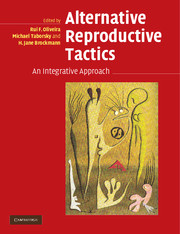Book contents
- Frontmatter
- Contents
- List of contributors
- Preface
- 1 The evolution of alternative reproductive tactics: concepts and questions
- PART I ULTIMATE CAUSES AND ORIGINS OF ALTERNATIVE REPRODUCTIVE TACTICS
- PART II PROXIMATE MECHANISMS OF ALTERNATIVE REPRODUCTIVE TACTICS
- PART III TAXONOMIC REVIEWS OF ALTERNATIVE REPRODUCTIVE TACTICS
- PART IV EMERGING PERSPECTIVES ON ALTERNATIVE REPRODUCTIVE TACTICS
- 16 Communication and the evolution of alternative reproductive tactics
- 17 Alternative mating tactics and mate choice for good genes or good care
- 18 Conflict between the sexes and alternative reproductive tactics within a sex
- 19 Cooperative breeding as an alternative reproductive tactic
- 20 Integrating mechanisms and function: prospects for future research
- Index of species
- Subject index
- References
20 - Integrating mechanisms and function: prospects for future research
Published online by Cambridge University Press: 10 August 2009
- Frontmatter
- Contents
- List of contributors
- Preface
- 1 The evolution of alternative reproductive tactics: concepts and questions
- PART I ULTIMATE CAUSES AND ORIGINS OF ALTERNATIVE REPRODUCTIVE TACTICS
- PART II PROXIMATE MECHANISMS OF ALTERNATIVE REPRODUCTIVE TACTICS
- PART III TAXONOMIC REVIEWS OF ALTERNATIVE REPRODUCTIVE TACTICS
- PART IV EMERGING PERSPECTIVES ON ALTERNATIVE REPRODUCTIVE TACTICS
- 16 Communication and the evolution of alternative reproductive tactics
- 17 Alternative mating tactics and mate choice for good genes or good care
- 18 Conflict between the sexes and alternative reproductive tactics within a sex
- 19 Cooperative breeding as an alternative reproductive tactic
- 20 Integrating mechanisms and function: prospects for future research
- Index of species
- Subject index
- References
Summary
CHAPTER SUMMARY
In this chapter we pull together the common threads of the other chapters of this book. In doing this we identify a number of issues that need further research. Rather than repeating what has been said before, we identify the features that stand out because they are unexplained, previously unrecognized or just neglected. We argue that to understand alternative reproductive tactics (ARTs) we must use an approach that integrates the study of mechanisms and evolution.
WHAT IS NEXT IN THE STUDY OF ARTS?
Continuous variation in reproductive characters (behavior, morphology, physiology) is found in all species but the real puzzle comes in understanding the special cases in which variation is discontinuous and thus constitutes consistent, discretely different ways of achieving reproduction for animals within one population. If one phenotype were just a little less successful than the other, then we would expect it to be eliminated from the population over time by natural selection. It is for this reason that the maintenance of ARTs is an evolutionary puzzle. ARTs are also a puzzle to geneticists, physiologists, and developmental biologists who must explain how one genetic and developmental program can result in two different phenotypic outcomes. Our chief challenge is to draw together the genetic, developmental, behavioral, and physiological views of ARTs to understand the evolution of the mechanisms that we see as alternative phenotypes.
- Type
- Chapter
- Information
- Alternative Reproductive TacticsAn Integrative Approach, pp. 471 - 489Publisher: Cambridge University PressPrint publication year: 2008
References
- 13
- Cited by



